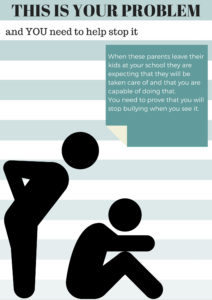Torina Gedler, Angela Geametto, Darpan Mehta, Pamela Mulhern
Bullying Final Post Draft
We’ve chosen two posters that a) Encourage students to get motivated by the Stand for the Silent program and b) Reminds the administration that tackling bullying is a big part of their responsibility. Our research indicated that the administration is usually very good at handling bullying cases that are overt (actual physical abuse such as punching or kicking or overt verbal actions such as name-calling and insulting) but not that great at handling the more covert aspects of Bullying. Covert bullying is the kind of bullying done out of sight and involves inflicting harm by damaging another’s social reputation, peer relationships and self-esteem. I.e. involving more relational bullying and threatening looks or hand gestures. Therefore, our posters need to tackle the more covert cases which we realize will be more difficult as we’re trying to bring about systemic changes and not just trying to implement a bullies get punished method.
As we’ve seen from our readings in this class and from the video ‘Bullying’, the conventional methods that have been used so far that focus more on an individual’s psyche don’t really address the problem. The bully is still likely to continue bullying. Instead, our method focuses on treating this as a systemic problem that can only be truly eradicated through making a change in student perceptions about bullying which the first poster aims to do. It is also very important to have a simple poster that encourages a child to look up a program that has much more information in it. Treating bullying is a vast subject and it’s more feasible to provide a starting point via a poster rather than cramming all the information in the poster itself. It also plays on the curiosity of students who are much more likely to learn that way instead of being subjected to posters and material that they are forced to learn.
Giving the bystander room to explore also addresses one of the main challenges of Bystander Programs. Most bystanders don’t step up even when they know bullying is occurring is because of lack of awareness of what steps to take to help stop the bullying. A Lack of awareness leads to lack of courage to step in as they aren’t sure as to what to do. A lot of bystander programs encourage students to step up but the students need to know how or want much more information before they take any action. Consider, also that different students are satisfied with different levels of awareness. Student ‘A’ might step when bullying occurs and tell the bully to cut it but Student ‘B’ might want to know more about what to do if the bully changes his focus to them or ignores them. A self-motivated approach that we propose via having a simple, yet inviting poster is to let the student decide how much awareness he/she needs herself before acting to do something.
The administration needs to realize the effect that they can have on preventing and stopping bullying. Student’s are not likely to report their problems to the administration if they feel nothing is being done when they do report. The administration needs to do continuing education in these areas throughout their time teaching as we learn new techniques to deal with bullying all the time. Bullying is also something that every instructor will see at some point in their career and the importance of combating bullying needs to be remembered with each student encounter. Parents are leaving their kids at school with the belief that they will be in safe capable hands and administrators need to realize how important that makes their jobs. The internet opens a wide area of possibilities for administrators to help combat bullying in their own school. They can reach out to other schools that have had success in lowering incidence of bullying on what they did and how that worked. There are various workshops available to administrators currently on the subject of bullying and each school district should research the best one for their school to take part in.
The administrators also have the responsibility to bring bullying prevention exercises to the students. The administration will have to take what they learn from their own experiences to the students in a way that the students will take it seriously. Administration needs to show the students the importance of the program and the gravity of the situation for the program to have any success. Once the workshop of sort has been presented to the students the administration should make available options for students to join Stand for the Silent or to encourage the students to making their own anti-bullying program. This type of take charge stance on bullying should especially be encouraged in the students that have the most influence and power in the school such as those on the student council. This would be important because these students are essentially the administration of the students and they already know that they have to power to make changes. The administration needs to realize that while they have great power to end bullying they also still need the students’ cooperation and help in making these important changes.
Research
http://www.nsvrc.org/bystander-intervention-campaigns-and-programs
https://www.notalone.gov/assets/bystander-summary.pdf
http://www.bullyingnoway.gov.au/teachers/facts/types.html




I really like your visual a lot. One of the things that I focused on in my paper, and that my group tried to focus on in our project as well was that everyone plays a part and there is always something that you can do, even if you have an indirect role in a situation. And your visual really puts the responsibility of acting on whoever sees the visual. Good post!
I liked how you highlighted that it is on the Administration to be proactive about making changes and encouraging bystanders to ‘stand-up’ for their peers around them. They have to make their students believe that coming to them will make a difference and something will be done about the situation as well. Also, your realization that bullying is likely to continue is very interesting, but rather that students perceptions about bullying, much more of a fundamental change which would thus overhaul everyone’s approach to bullying.
This is a really strong project and I really like your take on the administration. I really enjoyed the projects visual, it really points out individuals and connects the problems to everyone. What this project did was outline what we need to do to help and to relate to others. Great project!
I really like how they expressed the idea of their bystander programs and why it is necessary. Many people may not realize how important bystanders are in any bullying situation because they have the least to do with the situation. It is a common theme on how important a higher authority figure is in all of the topics and I like how they implemented the role of administration. I also thought the visual was very creative and it draws a lot of positive attention.
Ally Calvert
Bystander Group:
I really appreciate how you gave us a definition/ meaning to bystander, giving us a better way of trying to understand what you will be talking about in this post. I really like what you two had to say about social justice and how it is viewed as a systematic issue. Trying to reduce bullying is something that I find will always be a problem in schools and is not something that people think of lightly. I also really like what you had to say about Alex on the bus and how they were “just kidding around” this is a part that I feel people cannot tell the difference of “kidding around” and actual bullying, and this is something that needs to be brought to peoples attention. Great post!
I thought this was a great post! I think that people who are bystanders to bullying can do a lot to prevent bullying. More people need to be informed on the steps they can take to stop bullying. I thought this post and the posters did a great job of informing people what they can do to stop bullying.
I like the idea of implementing anti-bullying exercises and getting kids involved in anti-bullying. Bystandard and snitching, in a way, have similarities. We also felt the school system and students should get involved in the Stand for the Silent program.
I think you did a very nice just on talking about how bystanders could help the one getting bullied and how much of an impact that could have on the situation. I really believe that bystanders are the next best thing besides the bullied telling for themselves but without bystanders if the bullied doesn’t tell then there is no way of no so they could be a huge part in it. I really like your poster because it goes right in with it and draws positive attention. I also liked how you talked about Alex on the bus with those bystanders and how they said they were just kidding around, I believe there was one at least who did say they were actually bullying him and I think that is part of the problem kids are to scared to tell on others and even if they want to it is hard but I think once they are asked if it happened they are more like to tell us what happened than to just come up to us right away. Great post!
Packing th onus on administration is great because when it all comes down to decisions made administration has the bulk of the control and if anyone is going to be responsible why not those at the top. The only problem is sometimes to fix one problem school administrations can go overboard with their crackdowns.
I really like your visuals and the reasoning behind the simplicity. Great idea! Also, directing your information at administrators was excellent, as our group did something similar. Your idea that this is everyone’s problem and the different views you represent from students point-of-views were excellent. (Bullying victim, bystander, redirection of a bully)
I like the visuals this group made because they drew attention to specific targeted audience. People that would look at the first poster would automatically feel invited to think about what happens when leaving their kids at schools. It drives them from passivity of taking care of their child to think about if everything administration is doing is right. I like how they pointed out how big of an influence the administration has on reducing bullying. It is crucial for administration to pay attention to the bullies and find an active formula to take care of the problem.
Bystander Programs — Bullying Resolution Project
Visuals are appealing, I especially like the second one it’s very creative. I feel like these could be posted in schools to bring awareness for sure. The quote you used in the first poster from the movie bullying is a perfect summary, I remember hearing the parent say these words in the movie and it really resonating. Schools/Administration really do need to understand the gravity of bullying and the weight of ensuring childrens safety, not just physical like relational bullying pointed out.
Zachary Berman
Bystander Programs:
When i saw your topic, I figured you would talk about peers observing bullying, but was pleasantly surprised to see you write about administrative responsibility. You made a great point that the administration needs to step up and realize that it is their responsibility to deal with the issues faced in the environment they create.
Emily Tyler
Bystander Programs: This group did a good job of considering how kids would be more likely to learn and in an impactful manner. They started in a simple manner so as to not overwhelm the student, and then tried to engage them by piquing their curiosity. That way the students would be responsible for and hopefuly more invested the material they were learning about bullying. It’s a good beginning step to get bystanders to start becoming more meaningfully engaged participants in the effort to reduce and prevent bullying.